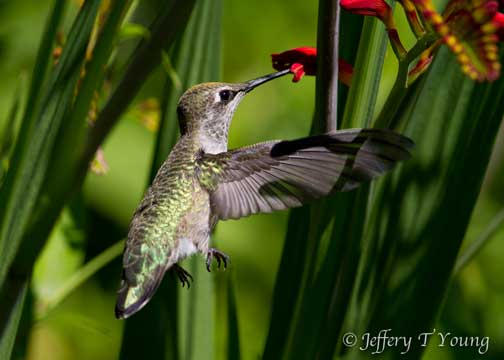The Nature of Cedar Mill
Hummingbirds
By Lauretta Young
Hummingbirds evoke interest and curiosity even for people who don’t identify themselves as bird watchers. One of the most asked questions I hear when I take clients out on birding trips is, “why don’t the hummers come to my feeder when I see them at the neighbor’s feeder?”
Hummingbirds live in the Americas from southern Alaska to the southern tip of South America and in the Caribbean. The variety of hummingbirds and the splendor of their coloration is truly amazing.
Here in Cedar Mill we have two varieties, the Anna’s Hummingbird, which is a year-round resident, and the Rufous Hummingbird, which migrates to Mexico for the winter. Both are about 4 inches long (the Rufous is slightly smaller) and their eggs are about the size of jellybeans. I once had the good luck in Tualatin Nature Park to see a hummingbird mother arrive back at the nest to feed her tiny chicks! The nest was so camouflaged on a tree branch that the tiny cup was almost invisible. These small birds tend to mate and hatch eggs relatively “early” in the spring, and the babies spend the rest of the summer growing on the abundant nectar found in native and yard flowers.
These two species do not tend to share well—in fact the Rufous hummers are so territorial they often completely dominate a yard and all it’s feeders and flowers if both species are in the same area. In the past week I have watched spectacular aerial “fights” with the Rufous chasing the Anna’s chicks away from feeders.
Reportedly they fly up to 30 miles per hour and by the blur of feathers I believe it. Sometimes spacing feeders out in a yard helps with this problem, but often the Rufous guard their entire territory so aggressively this strategy isn’t useful. Then one simply waits till the Rufous hummers leave for the summer to see any of the Anna’s come back into your yard.
If one has space and the interest in gardening, planting flowers they love is a good way to attract these small creatures to the yard. They seem to particularly love red flowers and of course flowers with nectar. Most nurseries have a section of hummingbird-attracting flowers. There are many websites with articles on how to plant for your area. I have found that most of the plants that attract hummingbirds also attract large numbers of butterflies, which is a bonus!
Designing a garden with nectar plants that bloom at different times is a great way to get more of these birds into your yard. Hummers tend to constantly check out their environment in set ways (called a trap-line strategy) to see what is blooming.
There are many models of hummingbird feeders. Almost all have the feeding station in red, to attract the attention of the birds. Most have features to discourage bees and ants. I have personally had good success with most models. A key to success is to get one that is easily cleaned. I believe that more important than the particular feeder model design is the freshness and concentration of the sugar mixture. It is not recommended to use commercially available mixes with red food coloring. Some experts believe that this may harm the birds’ liver. Nectar in the wild is colorless, the flowers are red but the nectar is clear.
A mixture of 1⁄4 to 1/3-cup sugar mixed into one cup of water is usually effective. The birds are on the move all the time. If they check the feeder sugar concentration and if it is too low on sugar they’ll move on. Another factor which really sends them away is a feeder with “old” sugar water. Heat and sunlight cause sugar water to ferment and develop fungus. Feeder water needs to be changed at least every 2-3 days in cool temperatures and sometimes every day when over 70 degrees. Clearly this may not fit into busy schedules!
One of my friends did all this and still did not attract any hummers—she had a very foliage-filled and green yard with shade. I advised her to put up a large “welcome hummer” sign by her feeder—in the form of a pot with large red flowers. She purchased Crocosmia which they love—and she had hummers the next day! Hummingbirds are very visual creatures.
People love watching hummingbirds; they bring a sense of joy and amazement to one’s day. In many cultures these tiny birds have symbolic meanings. We can all search for what they mean to us, but for many people they evoke amazement that such tiny wings can be so powerful. Or that these birds are able to drink in the sweetness of life despite being so fragile-appearing. What do they mean to you?
Lauretta Young is a retired physician who now teaches at OHSU mind body program and PSU in community health. She also takes out novice and experienced birders on customized bird tours in Cedar Mill and beyond. Check out her web site at www.portlandbirdwatching.com for more information or her husband’s photo web site for more amazing photos at: www.flickr.com/photos/youngbirders
|
